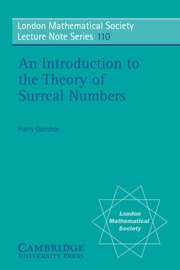Book contents
- Frontmatter
- Contents
- Preface
- Acknowledgements
- Chapter 1 Introduction
- Chapter 2 Definition and Fundamental Existence Theorem
- Chapter 3 The Basic Operations
- Chapter 4 Real Numbers and Ordinals
- Chapter 5 Normal Form
- Chapter 6 Lengths and Subsystems which are Sets
- Chapter 7 Sums as Subshuffles, Unsolved Problems
- Chapter 8 Number Theory
- Chapter 9 Generalized Epsilon Numbers
- Chapter 10 Exponentiation
- References
- Index
- Frontmatter
- Contents
- Preface
- Acknowledgements
- Chapter 1 Introduction
- Chapter 2 Definition and Fundamental Existence Theorem
- Chapter 3 The Basic Operations
- Chapter 4 Real Numbers and Ordinals
- Chapter 5 Normal Form
- Chapter 6 Lengths and Subsystems which are Sets
- Chapter 7 Sums as Subshuffles, Unsolved Problems
- Chapter 8 Number Theory
- Chapter 9 Generalized Epsilon Numbers
- Chapter 10 Exponentiation
- References
- Index
Summary
The surreal numbers were discovered by J.H. Conway. He was mainly interested in games for which he built up a formalism for generalizing the classical theory of impartial games. Numbers were obtained as special cases of games. Donald E. Knuth began a study of these numbers in a little book [2] in the form of a novel in which the characters are trying to use their creative talents to discover proofs. Conway goes into much more depth in his classic book On Numbers and Games [1].
I was introduced to this subject in a talk by M.D. Kruskal at the A.M.S. meeting in St. Louis in January 1977. Since then I have developed the subject from a somewhat different foundation from Conway, and carried it further in several directions. I define the surreal numbers as objects which are rather concrete to most mathematicians, as compared to Conway's, which are equivalence classes of inductively defined objects.
The surreal numbers form a proper class which contains the real numbers and the ordinals among other things. For example, in this system ω-1, √ω, etc. make sense and, in fact, arise naturally. I believe that this system is of sufficient interest to be worthy of being placed alongside the other systems that are being studied by mathematicians. First, as we shall see, we obtain a nice way of building up the real number system.
- Type
- Chapter
- Information
- An Introduction to the Theory of Surreal Numbers , pp. 1 - 2Publisher: Cambridge University PressPrint publication year: 1986



